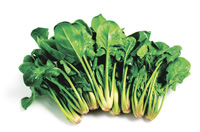
Features
Fruit
Production
Don’t let winter stop you from trying early crops says researcher
from trying early crops says researcher
April 1, 2008 By Allison Finnamore
Finding and developing new
vegetable crops in the Maritimes brings a few challenges for
researchers at Agriculture and Agri-Food Canada (AAFC), reports one of
the team members conducting research in the region.
Finding and developing new vegetable crops in the Maritimes brings a few challenges for researchers at Agriculture and Agri-Food Canada (AAFC), reports one of the team members conducting research in the region.
Josée Owen works out of the research station in Bouctouche, located in eastern New Brunswick. She says the low population of vegetable growers, combined with low acreage, stiff competition from outside the region and a cold climate, make finding successful new crops a tough job.
 However, Owen believes taking deliberate steps to ensure solid markets for Maritime-grown vegetables will ensure there’s a demand and a need to continue research into developing new or unique products to grow in the area. She is encouraging producers to employ direct marketing, such as farm markets, as much as possible and to diversify their crops to offer consumers a variety of products. As well, she suggests producers look to non-traditional crops or niche markets and adopt practices that can extend the Maritime growing season.
However, Owen believes taking deliberate steps to ensure solid markets for Maritime-grown vegetables will ensure there’s a demand and a need to continue research into developing new or unique products to grow in the area. She is encouraging producers to employ direct marketing, such as farm markets, as much as possible and to diversify their crops to offer consumers a variety of products. As well, she suggests producers look to non-traditional crops or niche markets and adopt practices that can extend the Maritime growing season.
With those key matters in mind, she has set out to investigate overwintering of spinach and leeks in eastern New Brunswick. Overwintering, Owen notes, is a way for producers to gain a place on the plate of winter-weary consumers.
“This is a way to capture early markets and premium prices,” Owen says.
Research trials with spinach involved either no cover at all or a floating row cover, while the leek production trials studied no covering, a floating, woven polypropylene fleece, and straw covering. Owen reports the straw cover provided the best insulation to the soil against the harsh winter conditions. That’s good news, she points out, since the fleece cover rang in at about 82 cents per metre, while the straw cost about 29 cents per row.
Because of the freeze and thaw of the 2004-2005 winter season, most of the spinach trials were lost. Owen says she’s hoping to repeat the trials again this season. The leeks, despite their appearance of a lost crop, ended up fairing fairly well in the overwintering trial.
When the row covers were first removed, it appeared as though the entire crop was lost, she recalls. Yet after a couple of days of spring sunshine and warmth, some of the leeks began sprouting. Within a short while, the plants were growing in a field that had just appeared to be devastated from the winter.
The straw row cover provided the best insulation and therefore the greatest yield results, she says. The leeks were small-sized, about one to one-and-a-half inches, but a quality vegetable, different from the larger leeks available later in the growing season. With continued research, Owen says she sees the opportunity to develop a slightly larger, higher-quality early leek.
“I think there could be a niche opportunity for baby vegetables,” Owen states, adding baby vegetables tend to net higher consumer prices. She acknowledges the young veggies do require more work, but adds the higher price often makes the additional output worthwhile.
Work will continue with overwintering both spinach and leeks in the Maritimes, she assures.
“It is possible to take our ugly, cold, harsh New Brunswick winter and use it to our advantage and have a marketable leek in the spring.”
Print this page